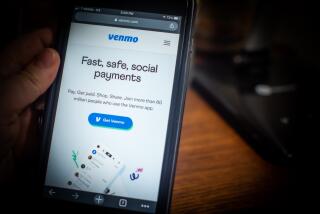Online Banking Can Be Boon for Parents and Spouses
- Share via
The Internet makes it easier than ever to spy on the finances of those you love--and that’s a good thing. Web-friendly bank accounts, credit cards and “stored value” cards can actually improve family relations and stave off costly financial disasters.
Parents, for example, can monitor the spending of their college-bound students and intervene before Junior and Sissy charge themselves into bankruptcy. Spouses no longer have to wait for end-of-the-month bank and credit card statements--with the unpleasant surprises they sometimes bring.
Even young teenagers can learn to use plastic with products like Visa Buxx, a card that’s a hybrid between a credit card and a debit card where the parent sets the limit on spending.
These tools are not a cure-all, of course. A spendthrift or secretive family member can subvert any financial program. And many people still aren’t comfortable with the idea of viewing their financial information on the Internet.
Only about 18% of the 90 million American adults who have online access use it to view their bank accounts, said Paul Jamieson, senior analyst for banking and payment services at financial research firm Gomez Advisors. That’s about 16 million people. Still, the number of online bank users is up about 45% from just seven months ago, which indicates that such access ‘is really gaining some traction,’ Jamieson said.
Most of those who try it are likely to be quickly converted by the convenience and new sense of control over their finances.
Dianne Wilkman is one such convert. As president of Consumer Credit Counseling Service-Inland Empire, Wilkman was mindful of the damage that people can do to their finances, and their credit ratings, through out-of-control spending. She’s particularly concerned about credit card companies that hawk high-interest credit cards to college students, who often have little experience in handling money.
At the same time, Wilkman wanted her daughter to learn how to use credit responsibly. So three years ago, Wilkman signed up for a joint credit card account with her daughter, then 17.
This was in the days before online access to credit card accounts was available, and sometimes Wilkman’s end-of-the-month statement included an unexpectedly high balance.
“She would spend more than she should have--on clothing, makeup, records,”Wilkman said. “She did abuse it every now and then.”
Eighteen months ago, Wilkman signed up for Internet access to the account. Now she logs on to the credit card company’s Web site about once a week to monitor her daughter’s spending. Although Wilkman can’t prevent a binge in advance, she can talk to her daughter if the balance gets too high. Just knowing Mom is watching seems to help keep spending under control, Wilkman said.
Parents--and spouses--can achieve the same kind of transparency by signing up for a joint checking account with their loved ones.
Instead of trying to keep track of ATM receipts and check amounts, families can view the information online or download transactions into personal finance software such as Intuit’s Quicken or Microsoft Money. (The latest versions of these programs make downloading transactions a breeze; most major banks and many credit card issuers allow users to whisk transactions from the financial institutions’ sites directly into the program’s registers with just a few keystrokes.)
Families can make it even easier to track their spending by using debit cards instead of ATMs or checks. Debit cards, also known as check cards, look much like credit cards but purchases are automatically deducted from the holder’s bank account.
When viewed on the Internet, debit card transactions usually include the merchant’s name and address--which could undermine Junior’s story that he spent all his money on textbooks, particularly if there are several transactions at Bob’s Brew Pub.
The other advantage to using a checking account rather than a credit card is that the user can’t run up an unpayable debt, since spending is limited to the amount of money in the account. That’s also the idea behind the new “stored value” cards such as Visa Buxx, a plastic card that parents “load” with a set amount of money that teenagers can spend anywhere Visa cards are accepted. The card can also be used to obtain cash from ATMs.
Trish Corbett works as a business analyst for the first bank to offer the cards, U.S. Bank of Minneapolis and signed up for a Visa Buxx card for her 13-year-old daughter Kelly as soon as they became available. Every two weeks, Kelly’s $15 allowance is automatically transferred from her mother’s checking account to the card’s account balance. Kelly also added $100 she earned over the summer cutting grass and baby-sitting. So far, Kelly has used the money for back-to-school clothes and ATM withdrawals.
U.S. Bank does not charge a fee to open a Visa Buxx account or to load the card, although transactions at other banks’ ATMs will incur fees.
Corbett said she likes the convenience of no longer being banker to her daughter, and the lessons in money management provided by the card. Both mother and daughter can sign on to the bank’s Web site to view Kelly’s balance and transactions.
There is a small chance that Visa Buxx users could overspend their accounts, since a few merchants still accept credit cards without first electronically confirming that the transaction doesn’t exceed the cardholders’ account limit. But since such electronic confirmations are routine for the majority of merchants today, Corbett said she isn’t too worried about Kelly going overboard.
“She keeps track of her balance in a little book they give you,” Corbett said approvingly. “She does really well with it.”
More to Read
Inside the business of entertainment
The Wide Shot brings you news, analysis and insights on everything from streaming wars to production — and what it all means for the future.
You may occasionally receive promotional content from the Los Angeles Times.








